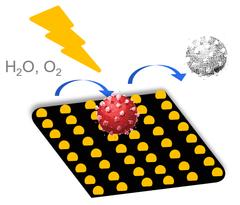URL: https://www.desy.de/news/news_search/index_eng.html
Breadcrumb Navigation
DESY News: CORAERO project: stopping viruses spreading
News
News from the DESY research centre
CORAERO project: stopping viruses spreading
The Helmholtz Association is taking a holistic approach to overcome the Covid-19-pandemic. How do we get out of the current crisis, how can we prevent new pandemics? Interdisciplinary collaborative projects from Helmholtz research centres that address these questions are now being funded as part of the campaign "The Corona Pandemic: Awareness, Management, Prevention". Scientists from the DESY NanoLab are also involved in one of the projects.
The research consortia are funded through the Helmholtz Initiative and Networking Fund as part of a pilot project for campaign-like pioneering projects, which is a new funding scheme of the Helmholtz Association. A contributed project to this campaign is called CORAERO - "Airborne Transmission of SARS Coronavirus - From Fundamental Science to Efficient Air Cleaning Systems" will benefit from the expertise of the Centre for X-ray and Nano Science (CXNS), where the DESY NanoLab is located. Heshmat Noei, scientific project leader at DESY and one of the workpackage leaders of the consortium says: “During the pandemic, we all learned more about the transmission of viruses via smear infections and aerosols. CORAERO focuses on researching and preventing virus transmission through aerosols and droplets.”Experts from medicine, biology, physics, chemistry, materials science, engineering and social sciences are working together to develop technologies to stop the spread of viruses. Six Helmholtz centres and four partner institutions are involved. Claudia Traidl-Hoffmann from Helmholtz Zentrum München is the scientific coordinator of the whole project. "We plan research and technology transfer for novel technologies that remove and inactivate SARS-CoV-2 and other viruses in the air and on surfaces," she says. The project received funds of about 6 Mio Euro and will run for 4.5 years starting in July 2021.

Heshmat Noei, Photo: DESY
DESY contributes with expertise in photocatalysis on surfaces and interfaces of oxide and metal nanomaterials.Heshmat Noei says: “Photocatalysis has been widely recognized as a promising tool in the field of viral dissemination. The mechanisms of the inactivation of the viruses are not definitively known and currently a limiting factor for the efficient implementation of such technologies is that they are typically hindered by slow reaction kinetics. This means that fundamental surface science studies are required to improve the efficiency of the catalyst by increasing reactive oxygen species production or enhancing surface adsorption via catalyst modification”. She continues: “The central focus of our project is to explore the interaction of the virus with the catalyst surface and the subsequent mechanism of the photo-induced inactivation of virus, designing nano-(photo)-catalyst materials for the inactivation of nano-organisms, synthesis and evolving the inactivation materials from photocatalysts to membranes and fibres for application in air sterilization systems using sustainable energy such as sun light.” Heshmat Noei explains: “our approach is to prepare and deliver the catalyst-based materials for wide spread technological application and large-scale viral inactivation.”
Andreas Stierle, leader of the DESY NanoLab and professor for nanoscience at the Universität Hamburg, is convinced that CORAERO is an exceptional, interdisciplinary project, which will demonstrate the power of the Helmholtz Association in tackling actual problems. “The DESY NanoLab is contributing its expertise in photocatalytic processes on oxide surfaces. This gives new stimuli in the understanding of virus inactivation on surfaces by light.”
The goal of this Helmholtz project CORAERO is to develop and transfer new technologies for use in schools, businesses, public transport and public places, so that drastic measures such as school closures are more likely to be prevented in the future.




